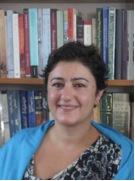Columbia University Spring Seminars on Iranian Studies
2/2/2012—5/14/20125:30 PM—7:30 PM
Faculty House of Columbia University 64 Morningside Drive New York, New York 10027
COLUMBIA UNIVERSITY SEMINARS
SEMINAR ON IRANIAN STUDIES
SPRING 2012 PROGRAM
Djavad Salehi Esfahani: February 2
Naghmeh Sohrabi: March 1
Mehdi Bozorgmehr: April 5
Ulrich Marzolph: May 14
*************************************
PROF. DJAVAD SALEHI ESFAHANI
Virginia Tech and the Brookings Institution
Thursday February 2, 2012
IRAN'S DIVIDED YOUTH

Summary
Young people play an important role in shaping Iran's politics but only a marginal role in its economy. They account for one-third of the population and are well educated, but they suffer from high rates of unemployment, more than three times the rate for adults. As a result, instead of a "demographic dividend" to spur its economic growth, Iran's burgeoning youth population has become a symbol of the country's economic stagnation and social malaise. In this talk I describe the challenges that Iranian youth of different economic and social background face in their transitions through school and to employment, and explore the reasons why Iran has not been able to take advantage of its demographic dividend.
Demography has seriously affected youth fortunes: the baby boom right after the Islamic Revolution of 1979 has led to an unusually large share of youth in total population. The nation's largest cohorts in its history have thus faced overcrowding in schools, intensified competition in employment and adverse conditions in family formation. These demographic pressures have been exacerbated by institutional problems in Iran's educations system and in its labor markets. The education system specializes in production of university degrees rather than productive skills. The formal labor markets, where educated workers queue to end up, is dominated by a public sector that bases its employment and compensation policies on degree and diplomas.
While demography is neutral with respect to economic and social status, these institutional structures are not. The playing fields in which Iranian youth compete for education and employment are highly uneven. Youth from better off families have a substantial advantage in succeeding in education and employment. I present evidence from Iranian survey data as well as international tests in which Iran has participated to show that family background and community characteristics play a large role in success in education. Inequality of opportunity in education and employment frustrate as well as divide Iranian youth. This is in contrast to 3 the (misleading) picture of Iranian youth as a uniform social group, which is largely a product of unequal access to social and other types of media.
I conclude by outlining the types of institutional reforms in education and labor markets that put a premium on skills over degrees as well as level the playing filed.
Bio-Notice
Djavad Salehi-Isfahani holds a BSc from University of London (1971) and Ph.D. in Economics from Harvard University (1977). He is currently Professor of Economics at Virginia Tech and Non-Resident Senior Fellow at the Brookings Institution and Research Associate of the Dubai Initiative, Harvard Kennedy School. He was Assistant Professor of Economics at the University of Pennsylvania (1977-84), visiting faculty at the University of Oxford (1991-92), and Visiting Fellow at the Brookings Institution (2007-08). He has served on the Board of Trustees of the Economic Research Forum (2001-2006), a network of Middle East economists based in Cairo, where he has been a Research Fellow since 1993, and on the Board of the Middle East Economic Association. He serves as the Associate Editor of the Middle East Development Journal and is on the editorial board for the Journal of Human Development and Capabilities. His research has been in demographic economics, energy economics, and the economics of the Middle East. He has coauthored, with Jacques Cremer, The World Oil Market, 1991, and edited two volumes: Labor and Human Capital in the Middle East, 2001, which was recognized as a Noteworthy Book of the year by the Princeton University Industrial Relations Section; and The Production and Diffusion of Public Choice Political Economy: Reflections on the VPI Center, with Douglas Eckel and Joseph C. Pitt, 2004. His articles have appeared in Economic Journal, Journal of Development Economics, Health Economics, Economic Development and Cultural Change, Journal of Economic Inequality, International Journal of Middle East Studies, and Iranian Studies, among others.
*************************************
DR. NAGHMEH SOHRABI
Brandeis University
Thursday March 1, 2012
“Taken for Wonder:
Nineteenth Century Travel Writings from Iran to Europe”

Summary
Nasir al-Din Shah (r. 1848-1896), the longest reigning Qajar monarch travelled to Europe three times during his rule. While he was not the first monarch from the region to travel to Europe, he was the first to record each travel extensively. This talk examines the king's European travelogues within the context of his other travel writings within Iran and to surrounding areas. Additionally, it examines the connections between Nasir al-Din Shah's travel writings, the extensive body of geographic works commissioned and translated during his rule, and the court's gazette, Iran.
Bio-Notice
Naghmeh Sohrabi is the Associate Director for Research at the Crown Center for Middle East Studies at Brandeis University. She received her Ph.D. in 2005 in History and Middle Eastern Studies from Harvard University. Her dissertation on Qajar travel writing to Europe received an honorable mention from the Foundation for Iranian Studies. Since then she has written and lectured on various aspects of modern Iran, including Iranian popular culture, history, and politics. She is a researcher on the National Endowment for the Humanities funded digital archive Women's World in Qajar Iran, and the editor in chief of the peer-reviewed monograph series Crown Papers. Her book titled Taken for Wonder: Nineteenth Century Travel Writings from Iran to Europe will be published by Oxford University Press in April 2012.
*************************************
PROF. MEHDI BOZORGMEHR
Graduate Center and City College, City University of New York
Thursday April 5, 2012
“New Data on Iranians in the United States from the Department of Homeland Security and the American Community Survey”

Summary
This talk will present new data on Iranians in the United States from the Department of Homeland Security (DHS) and the American Community Survey (ACS) conducted by the Census Bureau. The annual DHS data tell the story of the immigration trends of foreign-born Iranians, including immigrants admitted (new arrivals and adjusters), non-immigrants and refugees/asylees from the mid-1960s to present. The ACS data are based on an annual survey of a 1% sample of US households and contain ancestry, demographic and socioeconomic data 5 on foreign- and native-born Iranians. The merged multi-year data (e.g., 2005-07, 2006-08) are particularly useful for small populations such as Iranians. A comparison of the ACS and the 2000 US Census will be used to examine the recent social and economic trajectories of Iranians in the United States.
Bio-Notice
Mehdi Bozorgmehr is Professor of Sociology at the Graduate Center and City College, City University of New York. He is also the founding Co-Director of the Middle East and Middle Eastern American Center at the Graduate Center. He has been researching and writing about Iranian Americans since the mid-1980s. He has been commissioned by Encyclopedia Iranica to write a comprehensive entry on the Iranian American experience.
*************************************
PROF. ULRICH MARZOLPH
Enzyklopädie des Märchens Göttingen Universität
Monday May 14, 2012
“The Shahnameh in Print:
Early Printed Editions of the Persian National Epic”

Summary
The Shahnameh was first published in print at the beginning of the Nineteenth century through the effort of British colonialist scholars in India. Following Matthew Lumsdens unfinished effort to print the Shahnameh (1811), the epic's first complete scholarly edition was achieved by Major TurnerMacan (1829). Besides this editio princeps, several other scholarly editions, such as those by Jules Mohl (1838-78) and Johann August Vullers (1877- 79) appeared in the course of the nineteenth century, all of them printed from movable type. Meanwhile, the vast majority of the Shahnameh's early editions were produced in India and Iran where they were printed by way of lithography. After a short introduction into the history of printing in Iran, and particularly the history of lithographic printing, my presentation will discuss in some detail the Shahnameh's lithographed editions published during the Qajar period. Special attention will be devoted to the illustrated editions and their images.
Bio-Notice
Ulrich Marzolph is a professor of Islamic Studies at the Georg August-University in Göttingen, Germany, and a senior member of the "Enzyclopaedie des Maerchens," a research and publishing institution associated with the Göttingen Academy of Sciences. His particular research interest is the narrative culture of the Muslim Near and Middle East, both historical and modern. He has published widely on Arabic, Persian, and Turkish folktales and popular narratives, most recently editing several books on the "Thousand and One Nights". He has also contributed to the study of printing and publishing in Iran. His 2001 book "Narrative Illustration in Persian Lithographed Books" has been awarded the Iranian State Prize as an outstanding contribution to Persian studies.
To reach the Faculty House:
Enter the Wien Hall Gate on 116th Street between Amsterdam Avenue and Morningside Drive. Walk past Wien Hall, then turn right to the Faculty House.
Back to all events

